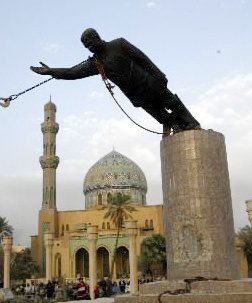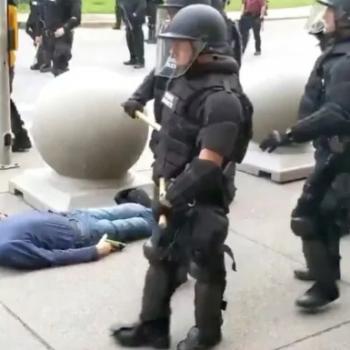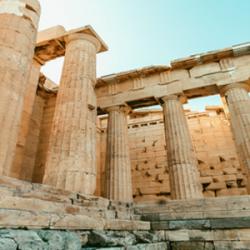
One of the most important propaganda moments of the US invasion of Iraq was when a crowd famously tore down the statue of Saddam Hussein. It meant that the US had liberated the Iraqi people from their great oppressor. Statues, like flags, communicate who is in power. The basic difference between the war in Iraq and the US Civil War is that the statues of the defeated oppressor came down in Iraq after he was defeated. Throughout the American South and particularly in the city of New Orleans, the statues of the champions of slavery went up after they were defeated to show that they hadn’t in fact been defeated. The purpose of erecting the statues of Robert E. Lee, Jefferson Davis, and other confederate heroes in the city of New Orleans was to show that the confederacy remained strong in the segregationist culture of the early 20th century.
The most troubling statue in New Orleans honors the Crescent City White League, a terrorist organization that overthrew the democratically-elected city government of New Orleans on September 14, 1874. The statue was built in 1891 as part of a series of initiatives on the part of the segregationist government that disenfranchised black people. A 1932 inscription on this said that the heroic deeds of the terrorist White League forced the Yankee “carpetbaggers” to “recognize white supremacy in the South and give us our state.”
This year, after the Charleston church shooting sparked outcry against public symbols of white supremacy, a coalition of pastors and community activists from New Orleans petitioned the city council to remove the confederate monuments and put them in museums instead of allowing them to continue to preside over prominent public spaces. Today, the city council officially voted to remove the statues. This afternoon, I met with one of the spearheads of the movement to remove the statues, Shawn Anglim, the pastor of First Grace United Methodist Church, the multiracial congregation where I worship on Sunday mornings.
Later this evening, I was at a Cub Scout meeting with a bunch of white parents whose kids all go to the only majority-white public school in New Orleans, the world-famous Lusher Academy. And they all started complaining about the statues getting torn down. I told them the story about the White League and asked them what part of that legacy they were interested in defending. They couldn’t hear me. To them, tearing down the statues was about erasing history through a misguided overzealous political correctness.
Perhaps this symbolic gesture doesn’t really mean all that much. It could certainly be critiqued as a cheap photo op on the part of a liberal white mayor who wants to score points with the black community. But I’ve seen too many posts today from students of color I know from Tulane that have talked about how proud they are of their city. As a white person, I completely ignore these statues. They just seem like part of the quirky architecture that makes New Orleans a weirdly sacred place, like the famous cemeteries with all their stone angels. But to a black person, what must it be like to drive past a statue of a man who dedicated his life to defending slavery or segregation? How can the statue not be a confirmation that segregation has never been defeated but lives on in the coded, wink-wink nudge nudge form of today’s Southern politics?
Statues are made of stone. They’re supposed to be permanent and immutable, just like the social forces that shape our world. When people start changing street names and tearing down statues, it makes the world feel unstable in a way that’s very frightening to middle-class white people. White people in this country have lived in a very stable world for at least the last 40 years. Black people have never lived in a stable world. In fact, the very forces that provide the stability of our world have been the source of their instability. There are certainly more substantive ways to fight racism than to tear down statues. But if it makes black and brown students I love feel like they matter and their city loves them, that’s all I need to see to know that it’s worthwhile.










